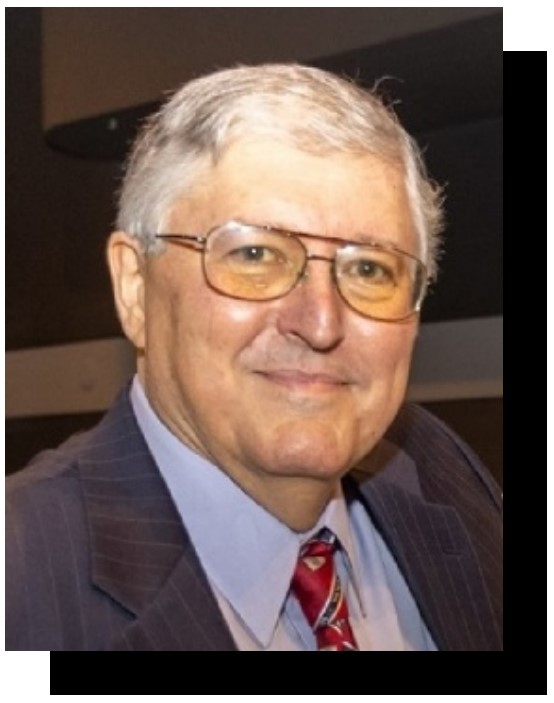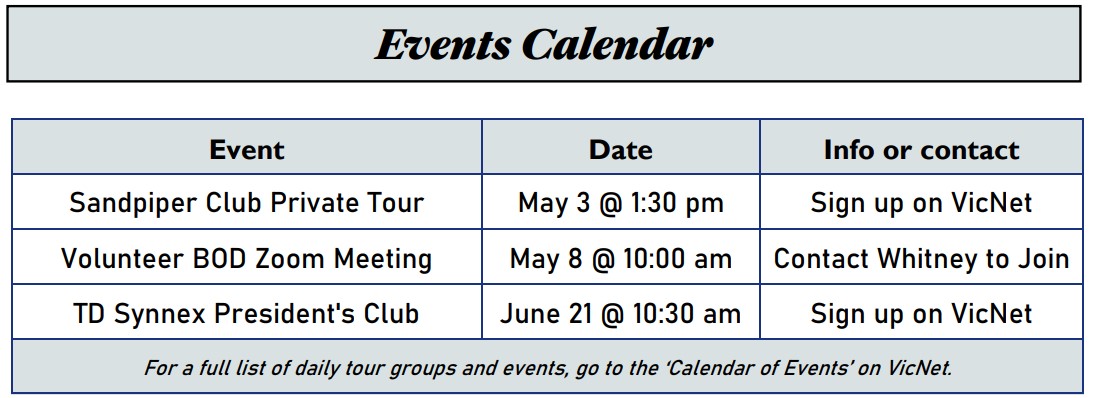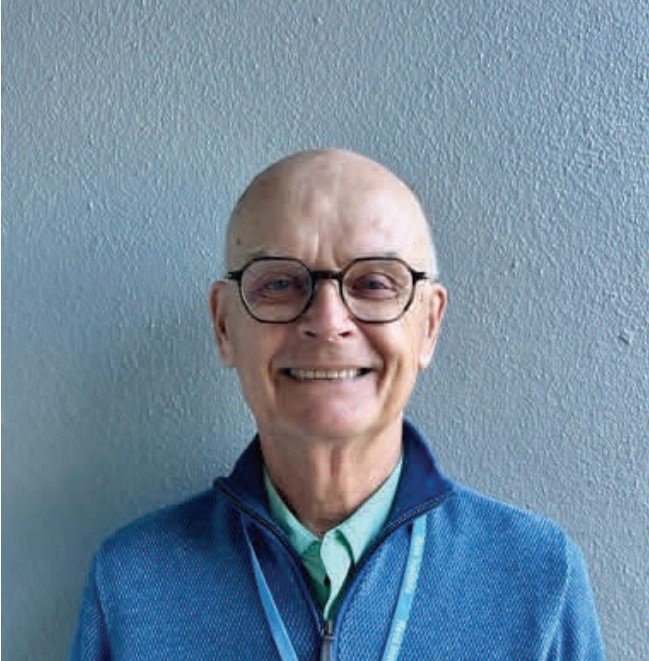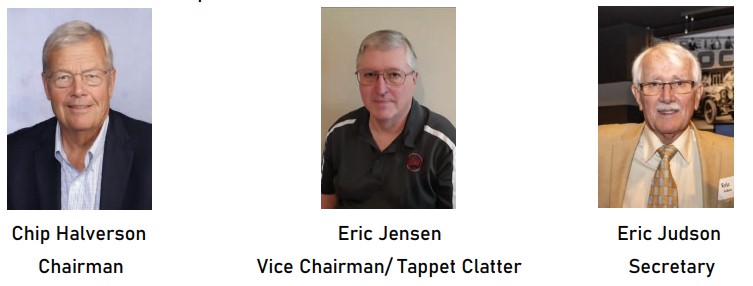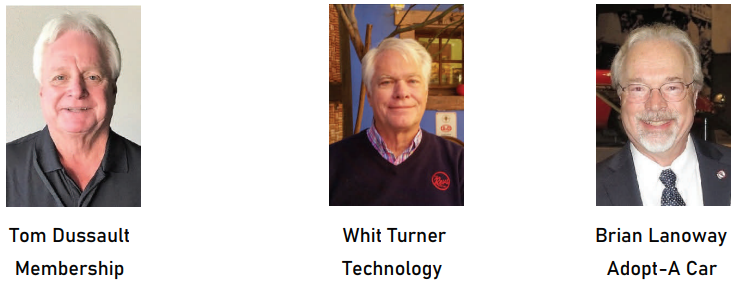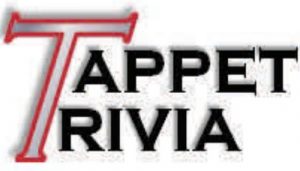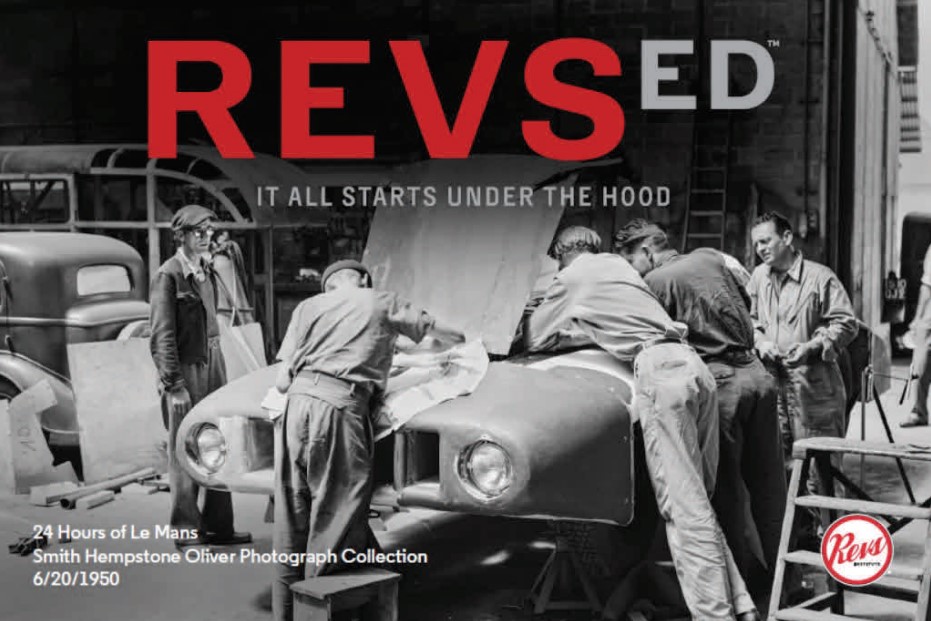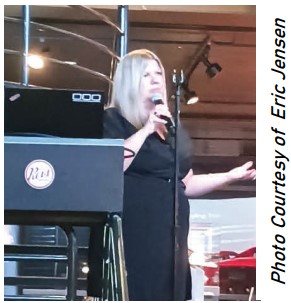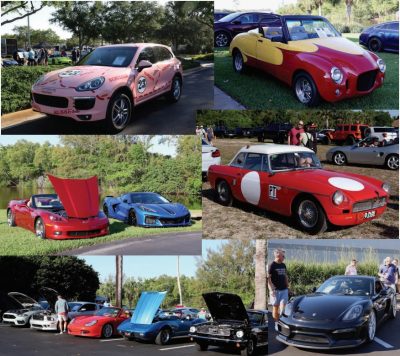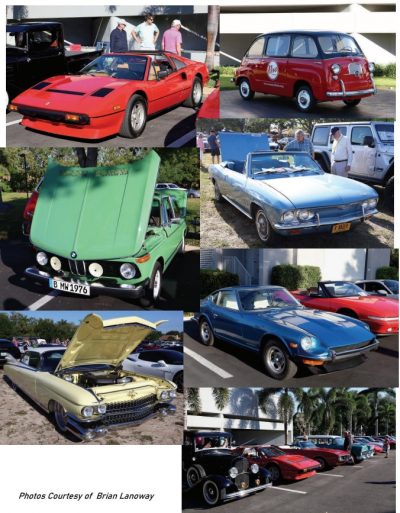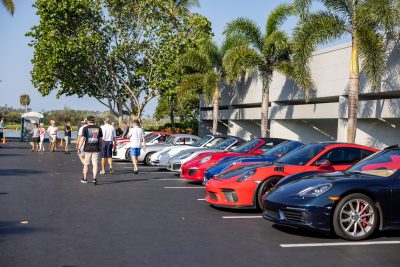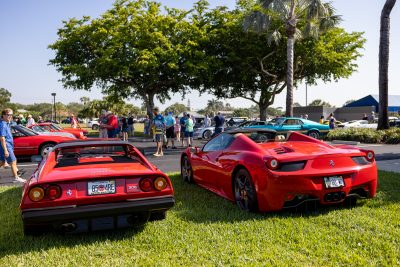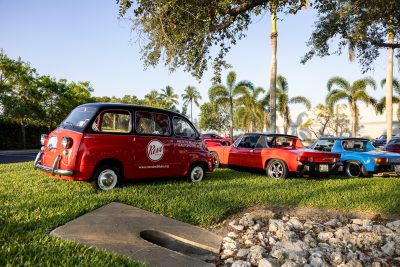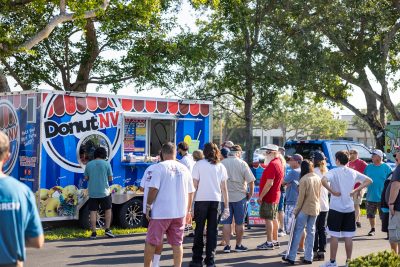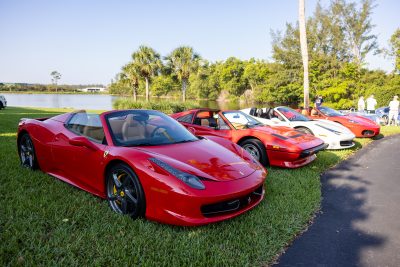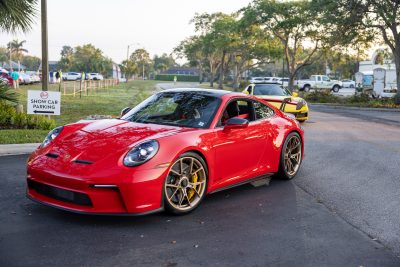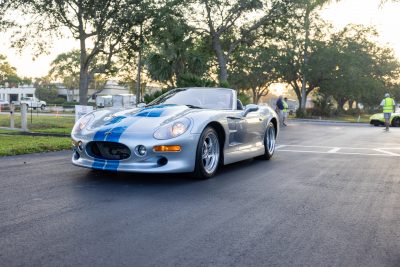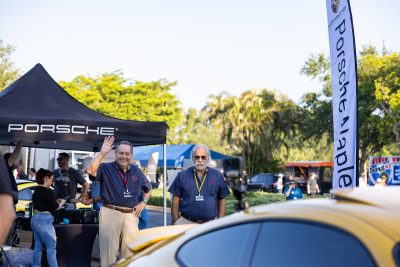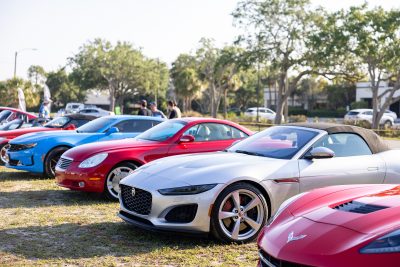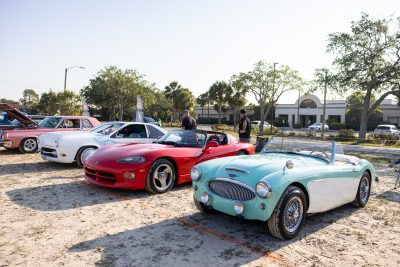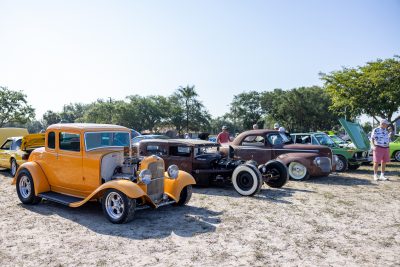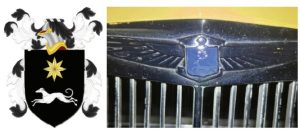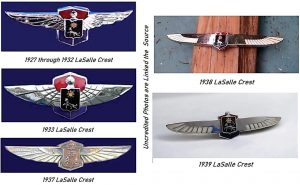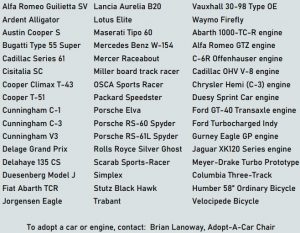Tappet Clatter
Volume 29.9 | May 2024 Editor: Eric Jensen Assistant Editor: Morris Cooper
Editor’s Notes
By Eric Jensen
As the 2023/2024 season comes to a close, this is the last Tappet Clatter issue until September. At the close of my 4th year as editor this is still fun. While I may contribute quite a bit to the newsletter, this is not the work of just one person. We are a band of 150 Volunteers (I always capitalize Volunteers out of respect to the organization!) with varied backgrounds and interests, many of whom contribute to the Tappet Clatter.
From those varied interests come articles, both short and long, about a wide variety of topics. The contributing authors like to write about the people, the technology, the competition and the history of 160 years of the greatest change agent of the 20th century.
Bill Vincent is still loading my inbox each and every month with interesting articles on a wide range of topics. I sincerely hope he does not run out of ideas! Morris Cooper continues to share interesting, thought provoking stories. Some of which are about French cars – a little understood subject here in the USA!
I can always count on Joe Ryan’s trivia questions to expand our knowledge and add bit of fun to the pages each month. Joe is one of several I pester each month for their regular updates to the upcoming issues.
Regular updates also come from our Chairman Chip Halverson, Membership Chair Tom Dussault, and our Volunteer Coordinator Whitney Herod.
Some new authors contributing articles this season include Bud Terbell, Whit Turner, Tom Stoll, Roc Linkov, and John Fritz. Returning authors included Pete Chehayl, Gene Jacobs, Mark Koestner, Ralph Stoesser, James Lanoway and Brian Lanoway.
I was asked what my next Tappet Tech topic was going to be by John Balconi one afternoon in the galleries. I told him I didn’t know… it hadn’t popped into my head yet! When it does,
I sit down, research and write. I encourage you, too, to be inspired to share thoughts that pop into your head; ideas for articles or the article itself. It may take a couple of months to schedule into the issue, it will appear.
Finally, it was nice to be recognized for our efforts by the American Association of Automobile Museums. But the Tappet Clatter has always been a publication for and by the Revs Institute Volunteers. I am proud to represent such an auspicious organization of Volunteers contributing their efforts to the best automotive history museum.
Have a nice summer and expect a Tappet Clatter issue in September.
Always Keep Writing!
Membership Report
The Membership Committee held its monthly meeting on April 9th. We are focusing on outreach to our newer members as well as finding ways to maximize volunteer participation in afternoon and weekend shifts. We also have a need for additional volunteers to fill the Guest Services role. Please let Whitney or I know if you can recommend a candidate for the Guest Services position.
The next monthly meeting of the Membership Committee is scheduled for Tuesday, May 14th at 1:15 pm. The Membership Committee is pleased to introduce Jim Jones as a new member of the Revs Institute volunteer team. Jim spent his early years in Gloucester, Massachusetts. Following Law School, he had a very successful career specializing in Patent Law. Jim’s practice involved a great deal of international travel, particularly to Japan, where he came to love the country and the Japanese people.
Jim spends his summers on the island of Martha’s Vineyard where he enjoys crewing on racing yachts. His classic cars have included a 1955 Porsche Speedster and a 1954 Austin Healey 100–4. The crown jewel of his collection is a 1954 Mercedes-Benz 300b Cabriolet 4-door convertible; one of 87 built. Jim had the honor of being invited to display his car at the 2023 Pebble Beach Concours d’Elegance. In fact, we were fortunate to meet and recruit Jim at the AACA Naples Car Show in March where his Mercedes took home the top award. Jim is very excited to join us in sharing the Revs Institute collection.Please be sure to welcome Jim Jones when he returns in the fall.
Gimmick Rally Correction
In the report from the recent Gimmick Rally this author incorrectly listed the winners, 2nd, and 3rd place finishers of the rally. This, despite sitting no more than four feet away from John Fritz while he announced it!
The winners were Eric and Ginny Jensen (much to the surprise of my spouse!), second place was Brian Lanoway and his son, Jordan, and third place was the car of Jim Wood, Peggy Wood and Casey Shepherd.
I apologize for the error and give special thanks to Brian Lanoway for catching it!
2024-2025 Volunteer Board of Directors
Each spring the Volunteers solicit candidates for the three open seats for our nine= person Board of Directors. If we have more than three candidates we hold a vote to elect the three. If we only have three candidates, they are elected by acclamation, which was the case this year. After the election, the Board votes to determine the officers for the coming year. Our 2024-25 board members are listed below with their officer or committee positions.
by Joe Ryan
This section is devoted to questions about the Miles Collier Collections cars or cars of the same period. Some of the questions might be a bit (very) obscure or (impossibly) tricky. Test your knowledge and have fun!
In each Issue of the Tappet Clatter, I provide questions that kindle a desire to increase information and knowledge about the cars at the Revs Institute. The purpose is to add to the knowledge of Station Guides, Docents and all at the Revs Institute. The trivia questions for this month are about the Briggs Cunningham 1964 Porsche 904.The 12 hours of Sebring was his last race before he retired from racing.
1. Question: What was Briggs Cunningham’s age at his last race in the
Porsche 904?
2. Question: Who was Briggs Cunningham’s co-driver in his last 12 hours of
Sebring?
3. Question: Is the Briggs Cunningham Porsche 904 in the Miles Collier
Collections completely original as built by Porsche?
4. Question: What did Briggs and his crew do differently to the back of the
Porsche 904?
5. Question: Why did Briggs add the leather straps over the rear of the car?
6. Question: What was the purpose of the flashlights mounted behind the
rear glass?
7. Question: What was the purpose of the light installed in the center of the
nose of the Porsche 904?
The answers appear later in this issue
April Member Meeting
by Eric Jensen
Every April brings Volunteer Appreciation Month. Every April the Revs Institute celebrates that event by providing unch for the Volunteers at our monthlyMembers Meeting. The speakers were our collector Miles Collier, interim Co-CEO, Bob Walton and Curator and Co-CEO, Scott George.
Volunteer Coordinator Whitney opened the meeting with a few slides on the strong growth in guest visits and the growth in Volunteer hours. More guests mean more Docent Tours, more Station Guides and more Guest Services volunteer help. None of this could be possible without the best volunteer organization in the country.
Mr. Collier opened his remarks with thanks to all the Volunteers for the effort we provide to Revs Institute and brought up a single slide. The slide was a map of his vision for the Revs Institute in the future decades; the car collection being but one part of the whole. The importance of the library and archives as a global reference for automotive research is underscored by the hiring of two archivists and the search for an archive manager. The growth of education beyond RevsEd, supportingfellowships at universities and teaching the skills and fabrication techniques of conservation and restoration is key to the future for Revs Institute. The goal is to be the resource for the automotive world.
Bob Walton introduced himself to the group and spoke of the near term work planned for the museum. During shut-down this August and September, new air handlers for the air conditioning will be installed as well as a totally new control system. In January, when it is cooler, the chillers in the outbuilding will be replaced. The system has outlived its service life. Since we’ve outgrown our library space (and two storage lockers!) a building off Alico Road near Fort Myers is being prepared to house those materials. It is about 20,000 square feet, 21 feet above sea level and will house the archive and offices. Research material can still be requested and delivered to Naples for research. For those of us that live north of Naples, this new
building will be a great convenience. Bob also informed us of the initiation a new CEO search since the last one did not identify a suitable candidate.
Last, but certainly not least, Scott George spoke about the pending completion of the 3 year restoration of the 1926 Bentley 3.0 liter being completed in England. It is just about ready for its 200 to 500 mile shake down run, if it ever stops raining! The Sunbeam from the Vitesse gallery is also undergoing a more correct restoration with the twin cam engine getting much of the focus. The Lancia D50 and B.R.M race cars have been shipped to Toronto to participate in an F1 display for several months. And finally, the 3rd floor display of the reassembly of the Alfa Romeo is being completed for the fall. Our guests will be able to see the care and detail it takes for an organized, proper reassembly of a conserved vintage automobile.
Cars and Coffee
By Eric Jensen
Spring is well upon us as was Revs Institute’s Cars and Coffee. Once again covering the museum grounds with great cars, interested spectators, enthusiastic museum guests and souvenir hunters. Saturday, April 6th was a busy day for all volunteers and staff to set up, greet and direct the show cars to the best spot we have available.
This April’s total car count did not quite beat 2023’s April event but it did exceed last November’s Cars and Coffee. There were many guests visiting the museum with strong souvenir sales. The Revs Institute staff and Volunteers continue to show how a cars and coffee should be organized!
The Lasalle Crest
By Gene Jacobs
While serving in the Automobility section of the Revs Institute, the badge at the top of the radiator of the 1934 LaSalle Convertible Coupe caught my eye. It had a design I had never seen before which prompted me to do a little research into its history and use on this vehicle.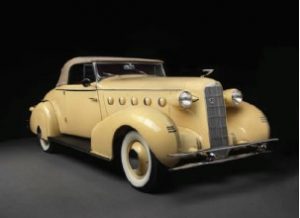
In looking up the history of this arrangement, I discovered that the vehicle was named after a French fur trader and explorer, René-Robert Cavalier, Sieur de La Salle. He was born in Rouen, France November 22, 1643. He was famous for leading an expedition down the Illinois and Mississippi rivers and claiming the region watered by the Mississippi and its tributaries for France. He named the region after King Louis XIV calling it “La Louisiane”; the modern-day Louisiana. La Salle’s expeditions built a network of forts from Canada across the Great Lakes and along the Ohio, Illinois, and Mississippi rivers. He was assassinated by disgruntled members of his exploration party in Texas on March 19, 1687. (note: LaSalle the car brand is spelled with no space, La Salle the explorer has a space, Editor)
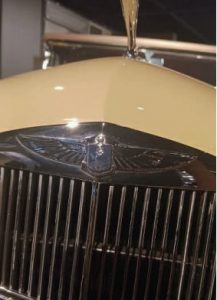 General Motors brands in the 1920’s era had a large gap between the top selling Cadillac and the next top priced brand, Buick. Lawrence Fisher, President, and General Manager of the top divisions of General Motors and President Alfred Sloan decided to fill this gap with the creation of the LaSalle brand that would be made and sold by the Cadillac division. The La Salle was marketed from 1927 to 1940 as a companion brand to Cadillac. The brand was priced between Cadillac and Buick. The LaSalle was shorter than the Cadillac and the second most prestigious brand in General Motors portfolio.
General Motors brands in the 1920’s era had a large gap between the top selling Cadillac and the next top priced brand, Buick. Lawrence Fisher, President, and General Manager of the top divisions of General Motors and President Alfred Sloan decided to fill this gap with the creation of the LaSalle brand that would be made and sold by the Cadillac division. The La Salle was marketed from 1927 to 1940 as a companion brand to Cadillac. The brand was priced between Cadillac and Buick. The LaSalle was shorter than the Cadillac and the second most prestigious brand in General Motors portfolio.
The head of GM design, Harley Earl, who was responsible for the creation of the La Salle automobile for GM, used the René-Robert Cavalier, Sieur de La Salle family crest incorporated into the badge at the top of the radiator. Wings were added to indicate speed (left).
The badge depicts a dog called a Whippet, a type of Greyhound with an 8-pointed star above the dog and a medieval knight’s helmet at the top. This then has wings on both sides of the crest.
Above right is a comparison of the Miles Collier Collections 1934 LaSalle badge on the right and the René-Robert Cavalier, 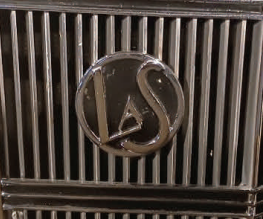 Sieur de La Salle family crest on the left. The position of the badge at the top of the radiator is often overlooked by viewers of the vehicle due to its size and the positioning of the large red LaS logo (right) on the radiator. Variations of the crest that have been used over the years by LaSalle can be seen below.
Sieur de La Salle family crest on the left. The position of the badge at the top of the radiator is often overlooked by viewers of the vehicle due to its size and the positioning of the large red LaS logo (right) on the radiator. Variations of the crest that have been used over the years by LaSalle can be seen below.
Additional Link: Cadillac & LaSalle Museum Amazing Classic Cars
HARLEY EARL…Design and Ultimate Salesman
By Morris Cooper
Born just before the twentieth century in Hollywood, California, Harley Earl (right) is considered the father of American automotive design and the best salesman in GM history. His contributions transcended his time at General Motors, revolutionising how cars were designed, manufactured and perceived by the public during the mid-20th Century.
Harley Earl’s automotive legacy is complex and not without criticism. Earl’s strategy involved annual model changes, creating a perpetual demand for the “newest” models and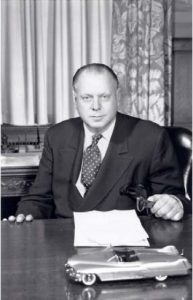 an unsustainable cycle where cars were quickly outdated by external design. As a result, although Earl never personally sold a car, he was praised as the best salesman at GM. GM became the dominant player in the American automotive market during his tenure, achieving a peak market share of over 50% in the early 1950s.
an unsustainable cycle where cars were quickly outdated by external design. As a result, although Earl never personally sold a car, he was praised as the best salesman at GM. GM became the dominant player in the American automotive market during his tenure, achieving a peak market share of over 50% in the early 1950s.
Earl pioneered a design strategy that was not just about the cars themselves but about successfully selling the image and lifestyle they represented.
Harley Earl was born into custom coachbuilding through his father’s business, Earl Automobile Works, where individuality and luxury were paramount. He had a talent for creating unique and eye-catching automobile bodies, which caught the attention of Alfred Sloan, the then-president of General Motors.
Sloan was looking for someone to lead a new department at GM aimed at integrating art into automotive engineering—a completely novel concept at the time. In 1927, Sloan invited Earl to join GM, which led to the establishment of GM’s “Art and Color Section,” the industry’s first design department, later known as the “Styling Section.” This was a period of transition at GM. The company sought to differentiate its products in a crowded marketplace, and Earl’s unique background had given him an instinctive grasp of American culture.
Styling as a Key Element of Automotive Design
GM’s radical move was a paradigm shift from viewing cars as purely utilitarian objects and seeing them as a canvas for aesthetic expression. Under Earl’s leadership, his department became responsible for overall form and functionality, laying the groundwork for modern automotive design departments. Earl’s vision was to design cars that performed well and appealed to the car buyer’s sense of style and fashion.
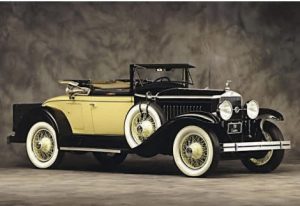 Earl’s first and most influential design at GM was the 1927 LaSalle (right). The LaSalle was one of the earliest mass-production cars designed by a professional designer rather than an engineer. The LaSalle bridged the gap between Cadillac and Buick in the GM lineup, but more importantly, it introduced a new market segment – the luxury car that combined performance with excellent design. It redefined the industry’s approach to car manufacturing and marketing. The beautiful LaSalle in Revs Institute’s Automobility Gallery is best described as eye candy, the integration of color choice and aesthetic design. LaSalles were built from 1927 through 1940.
Earl’s first and most influential design at GM was the 1927 LaSalle (right). The LaSalle was one of the earliest mass-production cars designed by a professional designer rather than an engineer. The LaSalle bridged the gap between Cadillac and Buick in the GM lineup, but more importantly, it introduced a new market segment – the luxury car that combined performance with excellent design. It redefined the industry’s approach to car manufacturing and marketing. The beautiful LaSalle in Revs Institute’s Automobility Gallery is best described as eye candy, the integration of color choice and aesthetic design. LaSalles were built from 1927 through 1940.
GM cars had become status symbols, symbolising American post-war optimism and technological prowess. Earl’s designs played a major role in cementing the car as a symbol of personal freedom and status in a cultural shift, albeit one that can be linked directly to the suburban sprawl across the country.
The Concept Car and The Motorama Auto Shows
Harley Earl invented the idea of the “concept car” with his 1938 Buick Y-Job (below). It was a prototype, not designed for production, but to gauge public interest and to showcase the direction of future designs. The Y-job featured innovations such as electric windows, hidden headlamps and an overall low profile.
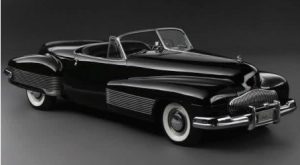 The “concept car” became a staple of auto shows, generating public interest and media buzz. Earl turned car design into a spectacle and a powerful marketing tool. GM’s “Motorama” shows, from 1949 through 1961, were extravagant exhibitions showcasing concept cars, new vehicle models and futuristic technologies.
The “concept car” became a staple of auto shows, generating public interest and media buzz. Earl turned car design into a spectacle and a powerful marketing tool. GM’s “Motorama” shows, from 1949 through 1961, were extravagant exhibitions showcasing concept cars, new vehicle models and futuristic technologies.
Design concepts like the tailfins on the 1948 Cadillac Series 62 (from the Lockheed P-38 Lightning aircraft) were more than just a stylistic flourish. They merged automotive design with a broader cultural fascination with aviation and space exploration. Critics of the tailfin cited its ostentatiousness and questionable practicality, yet its influence persisted into the late 1950s under Earl’s willingness to push design boundaries.
 Earl’s 1951 Le Sabre Concept Car (right) previewed a wrap-around windshield, jet-inspired bodywork, and advanced materials of aluminum and magnesium.
Earl’s 1951 Le Sabre Concept Car (right) previewed a wrap-around windshield, jet-inspired bodywork, and advanced materials of aluminum and magnesium.
Earl’s enduring legacy is the Chevrolet Corvette. Introduced in 1953 (below left), its sleek aerodynamic design and fiberglass body were revolutionary, challenging European dominance in the sports car segment and becoming an instant classic.
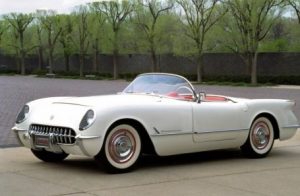 Cars were no longer seen as a means of transportation but as part of the broader narrative of American history and identity. They proved the power of design in shaping technological advancement and consumer culture. While his work was quintessentially American, Harley Earl’s influence was felt worldwide. His design-centric approach to car manufacturing inspired automotive designers and their design studios globally.
Cars were no longer seen as a means of transportation but as part of the broader narrative of American history and identity. They proved the power of design in shaping technological advancement and consumer culture. While his work was quintessentially American, Harley Earl’s influence was felt worldwide. His design-centric approach to car manufacturing inspired automotive designers and their design studios globally.
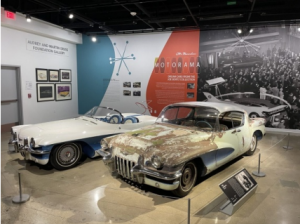
GM had little regard for their concept cars after they were shown. Most were ordered destroyed after their display usefulness had concluded and later in the corporate belt tightening during the 1958 economic recession.
A few have survived, as the Joe Bortz Collection, and were recently assembled and displayed in a remarkable new show which opened in late March at the Peterson Museum in Los Angeles.That show includes two of Earl’s late designs, the 1955 LaSalle II sedan and roadster. Bortz restored the roadster from its years of neglect. More impressively, from the standpoint of the Miles Collier Collections’ emphasis on preserving active artifacts, the sedan remains on display in its junkyard condition, reflecting the neglect and disregard of these historic show cars.
Today, as the automotive industry enters another paradigm shift, Harley Earl’s emphasis on innovation, aesthetics and the consumer experience remains entirely relevant. It offers valuable lessons on the importance of visionary thinking and design adaptability.
Penske Modine Radiator
By Bill Vincent
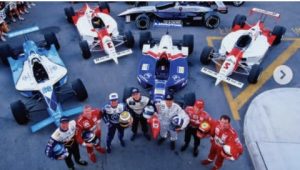
Karl Ludvigsen Photo Collection
So, back in December of last year there was a post on the Revs Institute Instagram page. It celebrated some of the drivers of the 1997 CART PPG Indycar World Series, with a few of their cars, in the background; two of them being the Penske PC-26 of that year.
Probably not an earth shattering post for most to get all hot over – but I was fortunate to have a close connection to those Penske PC’s of that era (right). I was involved in Modine Manufacturing’s unique cooling systems for those cars!
Funny enough, it all started pool side at a resort in Door County, Wisconsin.
At the end of the race season, there were some of us that would take turns hosting a relaxing “get-away” weekend. After that 1990 season, it was my wife Karen’s and my turn so we picked Door County. Earlier that past season, Danny Sullivan had lost the Road America race (while leading) due to a failed transmission cooler in his Penske PC-19 racecar.
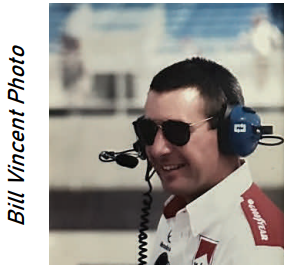 I was teasing one of my best friends, Steve Tredup (left), about why they were using the brand of transmission cooler they were? I had just stepped away from the Yorkshire MotorSports CanAm team and had gone to work with one of our sponsors, Modine Manufacturing. We used that same very troublesome oil cooler on the CanAm cars, so we had replaced it. Steve, who was then one of Penske’s gearbox gurus, said they used it was because it was the only one they found that would fit in the rear wing upright & mount.
I was teasing one of my best friends, Steve Tredup (left), about why they were using the brand of transmission cooler they were? I had just stepped away from the Yorkshire MotorSports CanAm team and had gone to work with one of our sponsors, Modine Manufacturing. We used that same very troublesome oil cooler on the CanAm cars, so we had replaced it. Steve, who was then one of Penske’s gearbox gurus, said they used it was because it was the only one they found that would fit in the rear wing upright & mount.
Well, Modine is a heat transfer company specializing in radiators, oil coolers, and other heat exchangers for the automotive, marine, and aircraft industries, among others. It was founded in 1916 and supplied the radiators for the Ford Model T. It might be best known for those box style furnaces you would see hanging from the ceiling in the corner of a store or warehouse – but that was then only about 10% of their business. I was then running Modine’s Sample Production Shops, making prototypes for customer testing and evaluation. Steve and I then agreed we’d each go back to our respective “teams” and propose the idea of Modine doing the cooling packages for the Penske PC Indycars.
Full disclosure: Penske also owned Detroit Diesel at the time and I thought this might open up opportunities for Modine there – which it later did!
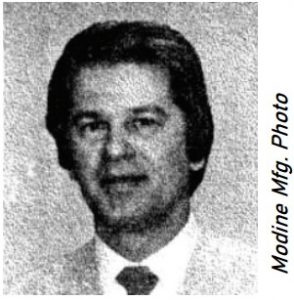 So with a verbal agreement, Modine started by supplying a replacement for that failed trans cooler! This was an air-to-oil unit using Modine’s “PF” Technology of the time. The “PF” stood for “Parallel Flow” and was used mostly in their air-conditioning condensers but was adapted, in this case, for oil by a great engineer named Greg Hughes (right).
So with a verbal agreement, Modine started by supplying a replacement for that failed trans cooler! This was an air-to-oil unit using Modine’s “PF” Technology of the time. The “PF” stood for “Parallel Flow” and was used mostly in their air-conditioning condensers but was adapted, in this case, for oil by a great engineer named Greg Hughes (right).
It then fell onto my group to figure out how to build it!
It used a webbed micro extrusion versus a normal flat open tube to carry the oil, giving the tube much greater strength. Being able to take a higher pressure without deforming the fins (on the air side) could be more detailed with louvers creating more surface area, for better airflow and heat transfer. Everything was aluminum, saving weight and bonded together with the clad coating on the aluminum. That clad coating was like chrome on a bumper. It melted a few degrees lower than the aluminum it covered, and when it did, it would act like solder and bond everything together as it cooled.
 That first trans cooler became a BIG hit and was even an unexpected surprise in a Marlboro ad campaign (left). But I’m guessing most people thought the “M” on the cooler was for Marlboro – and not the Modine logo/chevron below!
That first trans cooler became a BIG hit and was even an unexpected surprise in a Marlboro ad campaign (left). But I’m guessing most people thought the “M” on the cooler was for Marlboro – and not the Modine logo/chevron below!
So in March 1992, Modine and Penske signed an exclusive research and product development agreement for Modine to design and build the radiators and oil coolers for the PC Indycars. And then the Modine logo appeared on the cars just in front of the radiator inlets. 
As this was going on Nigel Bennett, who was Penske’s PC Designer/Engineer at the time, had been working on a design focused on having the least amount of “openings” in the car as possible. His goal, aerodynamically, was to only have “openings” for the driver (cockpit), air into the radiators, air out of the radiators, and air into the engine. This meant a different approach to cooling the engine and transmission oils.
Greg Hughes then came up with two water-to-oil heat exchangers, then called “bar plate coolers,” that were also made of aluminum and used the same bonding technique. They were a challenge to build, but gave Bennett the added bonus of being able to place them where he wanted in the car optimizing its weight distribution.
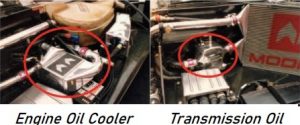 This also meant the radiators had a tougher job to do (right), coping with the cooling the engine and transmission oils! The race season back then also included a race in Denver, where the altitude (and thinner air) posed another set of challenges!
This also meant the radiators had a tougher job to do (right), coping with the cooling the engine and transmission oils! The race season back then also included a race in Denver, where the altitude (and thinner air) posed another set of challenges!
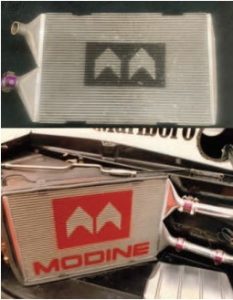 Spurred on by all of this Greg pulled another “rabbit out of his hat” and designed new radiators that used another, larger version of the webbed micro extrusion to replace the radiator tubes. This again, also allowed for the use of a more detailed louvered air fin, for better heat transfer, and was also bonded together by the aluminum’s clad coating (left). By this time my team had come to grips with being able to build whatever Greg was coming up with!
Spurred on by all of this Greg pulled another “rabbit out of his hat” and designed new radiators that used another, larger version of the webbed micro extrusion to replace the radiator tubes. This again, also allowed for the use of a more detailed louvered air fin, for better heat transfer, and was also bonded together by the aluminum’s clad coating (left). By this time my team had come to grips with being able to build whatever Greg was coming up with!
One of the unique features of these radiators, especially relating to that Denver race, was that they could take up to 2,000 psi! This made the Wiggins connectors (aerospace sealing clamps used in place of rubber hose and hose clamps) the weakest links in the cooling system.
After finishing in the top five of the championship in 1992, and 2nd and 3rd in 1993, everything REALLY came together in 1994. In fact the 1994 PC-23, with our cooling package, won 12 of the 16 races that season, finishing 1st, 2nd, and 3rd in the championship. That also included an Indy 500 win, with the infamous Mercedes push-rod engine, nicknamed “The Beast” (a story in itself)!
That PC-23 was also named “Automobile Magazine’s Race Car Design of the Year”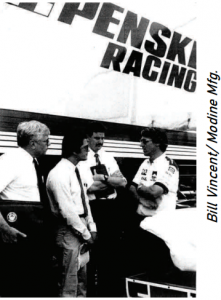
As the IndyCar series evolved and the rules changed, Penske stopped building their own cars, the Modine and Penske relationship came to an end, at least for the race cars. Modine did continue to produce products for Detroit Diesel.
It was a fantastic program to be involved in and created many fond memories and great friends! (right) Left to right Modine’s Director of R&D – Jim Rodgers, Senior R&D Engineer – Greg Hughes, Myself, and Penske Team Manager – Chuck Sprague.
Special thanks to Steve Tredup and the late Greg Hughes for their help in gathering up and saving some of the old details for this article!
.
.
.
To Roll or Not
Anti-roll bars
by Eric Jensen
.This month’s topic is anti-roll bars. These are also known as stabilizer bars or anti-swaybars or just swaybars. So what are they and what is their purpose?
We are all somewhat familiar with the springs that have supported automobiles since the very first Benz Patent Motorwagen. The springs flex with every bump to try to provide isolation between those bumps and the passengers. But what about turning?
As the auto rounds a turn, the springs on the outside compress from the turning and the inside springs extend. This makes the auto’s body lean away from the inside of the turn. If we make the springs stiffer, the body won’t lean as much but the ride becomes stiff and unpleasant. What if we could invent a spring that only works when the body leans in a turn? 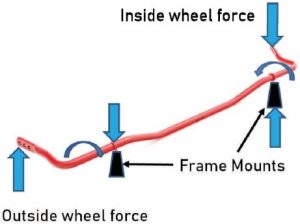
That invention is the anti-roll bar. It is a U-shaped piece of round spring steel bar that runs across the body connecting each wheel to the one on the other side. (Figure 1 ) The normal springs work in roll and bounce. The anti-roll bar is a spring that only works when the vehicle’s body rolls to one side or another.
The picture shows the U-shaped bar attached the frame of the vehicle at two points. The bar can twist inside those mounts when forces are applied upward from the wheel to the outside of the corner and downward from the inside wheel. The effect is to twist the bar exactly like a torsion spring. The diameter of the bar determines how much twist with a given wheel force. A larger diameter (thicker) bar will resist more and a smaller diameter (thinner) less. The combination of normal springs and the anti-roll bar allows the auto to have soft springs for a comfortable ride but reduce the roll (or sway) to provide greater stability.
comfortable ride but reduce the roll (or sway) to provide greater stability.
Now you know how the device got multiple names!
Anti-Roll Bars
.
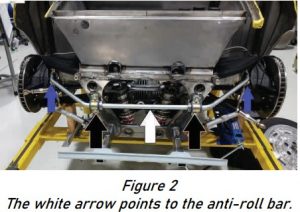 Anti-roll bars can be added to either the front or rear suspensions or both. There seems to be no record of the first use of the device but a peek under the rear of the 1934 Chrysler Airflow shows an anti-roll bar fitted to the rear suspension. An anti-roll bar can be seen at the front of the 1939 Bu-Merc. In Figure 2 you can see a silver anti-roll bar fitted to the front of the special project car being built in the shop.
Anti-roll bars can be added to either the front or rear suspensions or both. There seems to be no record of the first use of the device but a peek under the rear of the 1934 Chrysler Airflow shows an anti-roll bar fitted to the rear suspension. An anti-roll bar can be seen at the front of the 1939 Bu-Merc. In Figure 2 you can see a silver anti-roll bar fitted to the front of the special project car being built in the shop.
The anti-roll bar is a significant tool to help the handling of both road and racing cars. When turning a tight corner at speed, the driver wants not only stability but balance in the handling of the auto. Balance is achieved when neither the front nor the rear runs wide of the driver’s commands. This is the near-mythical “four wheel drift.”
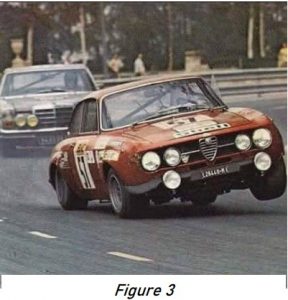 Since the anti-roll bar steals a bit of the inside tire’s load and transfers it to the outside tire, it makes the outside tire work a little harder to match the tires at the other end. It can be used to load up the front of a car with rear wheel drive so that the rear tires can accelerate the car (Figure 3 ).
Since the anti-roll bar steals a bit of the inside tire’s load and transfers it to the outside tire, it makes the outside tire work a little harder to match the tires at the other end. It can be used to load up the front of a car with rear wheel drive so that the rear tires can accelerate the car (Figure 3 ).
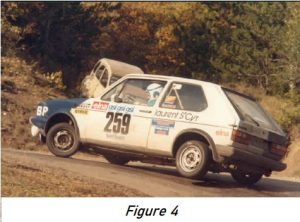 In a front-wheel drive car, it can work the rear tires harder so the front tires can accelerate the car (Figure 4 ). In the extremes of either example, the anti-roll bar can lift the inside tire off the road!
In a front-wheel drive car, it can work the rear tires harder so the front tires can accelerate the car (Figure 4 ). In the extremes of either example, the anti-roll bar can lift the inside tire off the road!
Many cars these days are fitted with both front and rear anti-roll bars for a flat ride and excellent handling. Taller SUVs are fitted with very large diameter anti-roll bars to limit their top-heavy wobbly feel.
By Joe Ryan
And Now The Answer….
.
.
.
.
.1. Q: What was Briggs Cunningham’s age at his last race in the Porsche
904? Answer: Briggs retired from racing in 1964 at age 57.
2. Q: Who was Briggs Cunningham’s co-driver in his last 12 hours of
Sebring? Answer: Lake Underwood. Lake and Briggs won their class
and finished 9th overall.
3. Q: Is the Briggs Cunningham Porsche 904 in the Miles Collier Collections
completely original as built by Porsche? Answer: No! Briggs, as he did
all his cars, enjoyed putting his personal touches on his race cars.
4. Q: What did Briggs and his crew do differently to the back of the Porsche
904? Answer: The crew hand-fabricated the rear engine cover of the
car from fiberglass to replace the heavy factory fiberglass cover. This was
to reduce the weight of the car. Less weight means added speed.
5. Q: Why did Briggs add the leather straps over the rear of the car?
Answer: To make sure the newly fabricated engine cover of the car did
not fly off at high speed.
6. Q: What was the purpose of the flashlights mounted behind the rear
glass? Answer: Rules require the rear of the car to be lit during the
race at night. In case of a power failure, burned out taillight, or minor
crash, the flashlights could be quickly illuminated at a pit stop and the car
could continue to race.
7. Q: What was the purpose of the light installed in the center of the nose of
the Porsche 904? Answer: No one knows the answer as to the purpose
of the light, or when, or if the light was ever used.
The source for the May Trivia Column is from an interview with our Curator,
Scott George!
Contributions to the column are always welcome.
Adopt-A-Car Program
Available Adopt-A-Car Automobiles And Engine
The Tappet Clatter is the official newsletter of Revs Institute Volunteers of Naples, Florida. Its intended purpose is
to inform, entertain and promote camaraderie for our members.
The editor is Eric Jensen, [email protected]. Although email is preferred, correspondence can be mailed to:
The Tappet Clatter, 2500 South Horseshoe Drive, Naples, FL 34104.
The Tappet Clatter welcomes contributions from all sources. Contributions are subject to editorial review and
enhancement. The editor may use third party input to confirm content. Authors can have the right to review and
approve the final version of their article before publication. All ideas and opinions are those of the writers. Neither
the Tappet Clatter editor nor the Board of Revs Institute Volunteers assumes liability for the information contained
herein.
The Tappet Clatter respects the copyright of all sources. However, the Tappet Clatter may choose to use copyright
material if that use meets all four factors of the Fair Use exception identified in United States copyright law. Unless
otherwise noted, photo sources can be identified by clicking on the photo.
The Volunteers’ edition of the Tappet Clatter is not to be reprinted or electronically distributed beyond the
membership of The Revs Institute Volunteers without prior written permission. There is a public edition of the
Tappet Clatter available on the Revs Institute website. Rights of reproduction, in printed or electronic media, are
retained for any text or photographs submitted. The Tappet Clatter reserves the right to refuse publication, edit, or
modify any material and hold such material for an indeterminate period.
@ 2024 REVS INSTITUTE VOLUNTEERS, ALL RIGHTS RESERVED.


